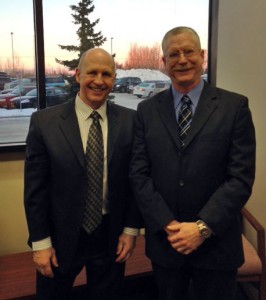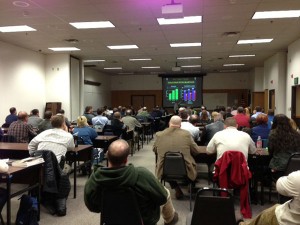Law enforcement officers from across the state have spent the past two days in a training on the use of deadly force. The workshop comes after two deadly, high-profile suspect shootings by Anchorage police officers in 2012. The training is focused on science.
An officer responds to a call. The suspect resists. The officers shoots. It’s a situation that we’ve heard about too often lately in Anchorage. Anchorage Police Department officials hope a training this week will help officers avoid deadly shootings whenever possible and help them to explain them better to the public when they do happen. Dr. Bill Lewinski is with the Force Science Institute, a research, consulting and training organization focused on human behavior in use-of-force situations. Lewinski says he is teaching officers a scientific approach to field work and investigations by looking at something he calls human dynamics, or how human beings react in high stress, life-threatening encounters.
“What we’re looking at is within those dynamics, what’s the best way possible to train an officer so that the officer makes the most effective decision possible,” Lewinski said.
Lewinski says science can help law enforcement officers with decision making in an emotionally charged situation. And it can help them more clearly look back at what happened after the fact, by setting the parameters. He gives this example.
“An officer says he saw a person’s hand begin to move and fired. And when we look at the reaction time, I’m citing an actual case, the person’s hand began to move less than a quarter of a second before the officer fired,” Lewinski said. “We know from research on perception, visual perception on reaction time that officer is either the officer is the fastest person on the face of the earth or what their telling us didn’t happen.”

Such scientific parameters can be helpful in preventing and solving all sorts of cases, Lewinski says. Officers came from as across Alaska, but the the majority who attended the training are with the APD. Lieutenant Derek Hsieh, the President of the Anchorage Police Department Employees Union, says he helped bring Lewinski to Anchorage as a response to last year’s officer involved shootings.
“So after we had a number of high profile use of force, or as we call it, response to resistance issues here in Alaska, including deadly force for us, the Alaska State Troopers and a number of other law enforcement agencies, I thought it would be a real benefit to bring Dr. Lewinski and force science to Alaska to people better understand what’s happening,” Hsieh said. “Not just the public, our officers, but most importantly the people who investigate these cases and the prosecutors as well.”
On June 9, an Anchorage police officer shot and killed Shane Tasi who was brandishing a stick in the Mountain View Neighborhood, calling it a deadly weapon. Less than a month later Harry Smith was shot and killed in South Anchorage by Anchorage Police officers after the 59-year-old pointed a BB gun that looked like a real gun at Police. The training officers are getting this week is a supplement to on the job training, which Hsieh says has not caught up with science.
“Policing has changed a lot over the last 50 years and its become much more academic and I think Dr. Lewinski is kind of a bi-product of that need,” Hsieh said. “What Dr. Lewinski does is he applies scientific standards to testing and research.”
“Prior to looking at cases they use time lapse photography, they’ll use a number of test subjects. They’ll evaluate it very closely from strict scientific standpoints.”

Lieutenant Anthony Henry oversees the Homicide and Robbery departments at the APD. He says he wants the public to know that the APD does not take lightly the use of deadly force. He says he believes the scientific training will help officers make better decisions about and more accurately investigate deadly force incidents.
“It’s real easy for the public to recognize or understand and have no questions about a shooting that occurs when a suspect produces a gun,” Henry said. “It’s usually the toy guns, the BB guns or non-traditional weapons.”
“They create controversy, but they are no less deadly, and that’s the thing that sometimes the general public doesn’t understand and we got to be better as a police agency be better able to explain those events.”
Lieutenant Henry says he hopes to bring the full training program to Anchorage for his Homicide Unit, if the funding is available. The training this week cost more than $18,000 and was paid for by the Alaska Police Standards Council. It ran Monday and Tuesday and was not open to the public.
Previous stories:
- Anchorage Shootings Topic of Town Hall Meeting
- Man In Officer Involved Shooting Was Holding BB Gun
- APD Shootings Spark Rally, Community Concern
- Meeting Planned to Address Shootings
- APD: “The police department does not have a ‘shoot to kill policy’”
- APD Officers Cleared In Deadly July Shooting
- Hometown, Alaska: Anchorage Police and Deadly Force
Listen to the full story
Daysha Eaton is a contributor with the Alaska Public Radio Network.
Daysha Eaton holds a B.A. from Evergreen State College, and a M.A. from the University of Southern California. Daysha got her start in radio at Seattle public radio stations, KPLU and KUOW. Before coming to KBBI, she was the News Director at KYUK in Bethel. She has also worked as the Southcentral Reporter for KSKA in Anchorage.
Daysha's work has appeared on NPR's "Morning Edition" and "All Things Considered", PRI's "The World" and "National Native News". She's happy to take assignments, and to get news tips, which are best sent via email.
Daysha became a journalist because she believes in the power of storytelling. Stories connect us and they help us make sense of our world. They shed light on injustice and they comfort us in troubled times. She got into public broadcasting because it seems to fulfill the intention of the 4th Estate and to most effectively apply the freedom of the press granted to us through the Constitution. She feels that public radio has a special way of moving people emotionally through sound, taking them to remote places, introducing them to people they would not otherwise meet and compelling them to think about issues they might ordinarily overlook.




